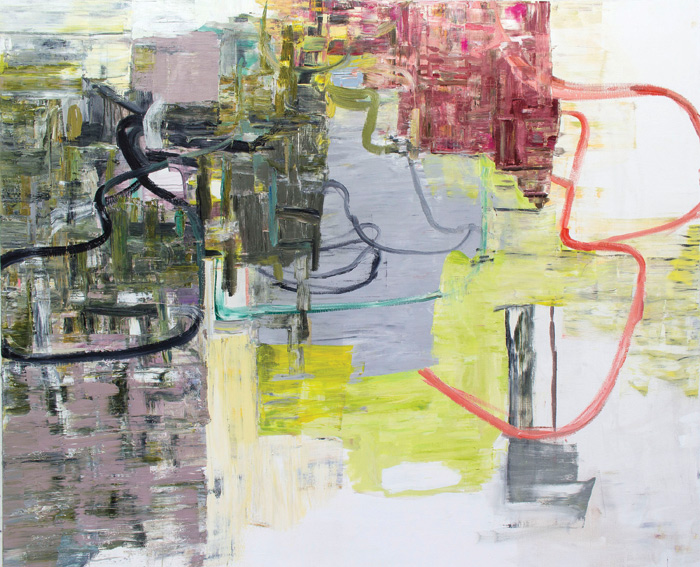Deborah Dancy
Five Points Gallery • Torrington, CT • fivepointsgallery.org • July 11–August 10, 2019
In The Weight of the World (2017), the mid-sized acrylic painting on paper after which Deborah Dancy’s solo show is named, a pink grid hovers over a heavy, viridian mass near the top of the composition. Dancy, a John Simon Guggenheim Fellow, completed this work the same year she retired from the University of Connecticut after 35 years. As in other recent works, this net—with its salmon hue that looks sweet and grotesque—is, by turns, a type of enticement and entrapment. Throughout Dancy’s show, the agitation of her marks—the serpentine strokes of black, muted patches of gray that read as erasure, and evidence of frenzied wiping, scraping and removal of the paint—points to a generalized feeling of anxiety that Dancy experienced during the spring of 2017 following the presidential election.
Deborah Dancy, East Meets West, 2017, oil on canvas, 64 x 70″. Courtesy of the artist.
The largest work in the exhibition, East Meets West (2017), communicates similar tangled states and chaotic systems. Several bright red swirls dangle from the side of a blurred magenta splotch near the canvas’s top right corner. These jarring lines seem to want to connect to something, but instead, they end abruptly. Dancy delights in the ambiguity of these elements, pushing the paint around until she finds the precise shape. Through the process, she strives for subtle connotations that can express power, pain or longing.
Alongside Dancy’s three paintings on paper, two others on commercial drop cloths and two oil paintings on canvas are several of her collection of porcelain figurines from the Ship of Fools series. Dancy scours local flea markets for these bizarre tchotchkes, stamped “Made in Occupied Japan” to indicate their post-World War II provenance. She describes these collectibles—particularly, the white colonial men and women—as a painful cultural jab. These problematic characters present an idealized interpretation of America’s early settlers that sanitizes their involvement with the slave trade. Adding globs of paint or clay in obtrusive ways, Dancy alters their exteriors. This drastic disruption to their appearances functions as a critique. While Dancy’s paintings exploit the subtly and simultaneity of an abstract language, these modified small-scale sculptures are pointed. With their sardonic humor, they also help inform the other intelligent works in Dancy’s show.

